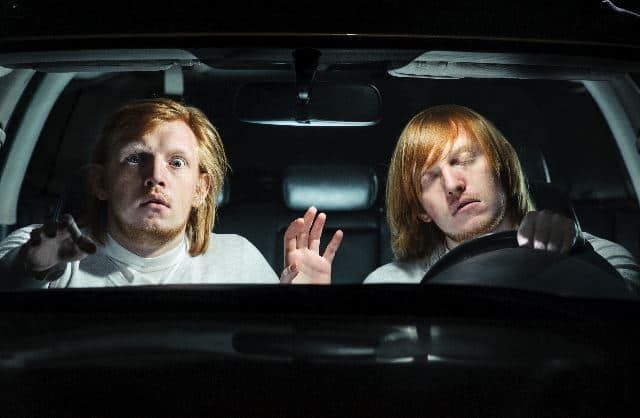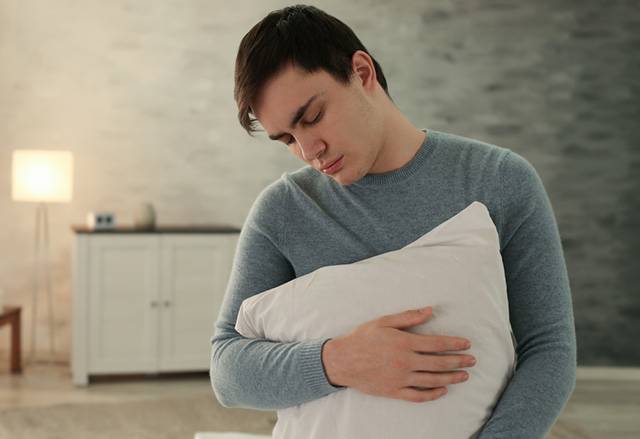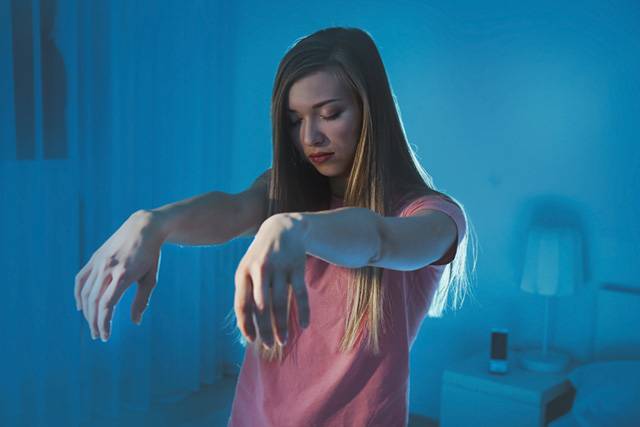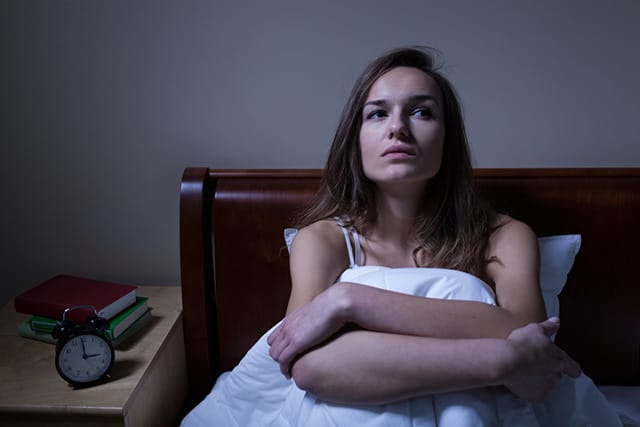The term sleepwalking is common enough that everybody has heard of it, but it is not so common that everyone will experience it. Though it may be something people have heard of, that is not to say they know what it is. Sleepwalking is not just a single thing; there are multiple factors which go into it, and there are multiple things which can be classified as sleepwalking.
What is Sleepwalking?

Man falling asleep behind the steering wheel, while his twin is terrified, trying to warn him of an imminent collision
In the way that everyone thinks, sleepwalking is when someone finds themselves walking during their sleep. There are multiple misconceptions surrounding the idea of sleepwalking which is classified as a disorder, and this is one of them. Sure, people may indeed walk in their sleep, but sleepwalking can also be classified as talking in one’s sleep or sitting up and looking around. Sleepwalking can also go as far as involving complex actions such as driving.

Waking a sleepwalker does come with risks, however, as most sleepwalkers do not know they are doing it, which can lead to somewhat violent awakenings or at least a bit of a scare for the sleeper.
What Causes Sleepwalking?

Some of the more common suspects are sleep deprivation, fever, being excessively tired and increased slow wave sleep. However, none of these are proven to be actual causes, just theories.
Something interesting about sleepwalking is that it may, in fact, be genetic. One study found that 45 percent of children who walked in their sleep had a parent who did as well. If both of the child’s parents walked in their sleep, that number rose to 60 percent of children.

Statistics also show children with sleep apnea are more likely to sleepwalk than those without, and children who experience issues with bedwetting are also found to sleepwalk more often.
Diagnosing Sleepwalking
Do you find yourself waking up somewhere different from where you went to sleep? Perhaps things have been moved around in your living room or kitchen overnight? Could this be a haunting? We will leave that up to the ghost hunters, but maybe you are actually sleepwalking at night. How can this be diagnosed?
There are a few things which go into diagnosing a sleepwalking disorder. The first is a physical exam to check for anything that can be linked to sleepwalking. There are other conditions that can be seen as sleepwalking such as nighttime seizures, night terrors, and other sorts of sleep disorders.
Step two would be to discuss what is going on, the symptoms and experiences you have been having. If you live with someone, they will likely be able to tell you what you have been doing in your sleep. Bringing them to the appointment could also be of great help, as your doctor may have better and more specific questions.

A sleep study will, in theory, be able to see what may be affecting sleep to the point of experiencing issues such as sleepwalking disorder.
Treating Sleepwalking
The key to treating sleepwalking depends entirely on what is causing it. This, again, is something not easy to pin down. Some things are more obvious such as trying to get more sleep when you find you are not getting enough. If you are only sleepwalking on nights when you are too tired to function, then therein may lie your answer.

Self-hypnosis, which may sound a bit extreme, is thought to allow someone to bring about changes in their life through suggestions made during hypnosis which can help adjust sleep cycles and issues with actions taken during sleep.

Scheduled awakening will take a bit of time, as it requires someone to keep an eye on the sleeper to find out at about what time they typically sleepwalk. The key to the technique is to wake the sleepwalker about 15 minutes or so before they start to do their nightly sojourn. By doing so, they can wake then fall back to sleep, skipping over periods where sleepwalking may likely occur.
Should the situation get too common or start becoming detrimental to a patient’s health, a doctor can also prescribe medications as a viable treatment, specifically anti-anxiety medications such as benzodiazepines or some sort of antidepressant.
What Can Be Done to Combat Sleepwalking?
When it comes to fighting sleepwalking, prevention is key. When you know you’re a sleepwalker, certain things should be taken into consideration for your safety and the safety of others. When sleepwalking is a fact of life, this is just the simple truth.


In order to make sure your sleep is quality sleep, one should also do their best to make sure they are creating good sleeping habits. Creating a before-bed routine is a great way to get your mind and body ready for the sleep to come, helping you to fall asleep more easily and have a more restful sleep.
This can include meditation, massage, a warm bath, reading a book, or anything else which could be calming for you. Things to avoid are television screens, mobile devices, or other things that will put off blue light since it will stimulate your brain to stay awake.

You should also avoid things which can directly impact your sleep such as alcohol, spicy foods, caffeine and other stimulants and chemicals. These things keep you from being fully rested and should be skipped as bedtime draws near.
Finally, and perhaps most importantly, you have to realize that sleepwalkers need to be in a safe environment. In extreme cases, sleepwalkers have been known to go outside or do other things which could cause them harm. Making sure doors and windows are closed and locked can keep a sleepwalker from venturing outside.
Keeping pathways clear of items on which someone can trip will make sure the sleepwalker isn’t awoken by a hard fall. If possible, all weapons and sharp objects should be put away as well. No precaution should be considered too extreme when it comes to the safety of family and friends.
Sleepwalking Complications


Sleepwalking and sleep terrors are both classified as a parasomnia, and they can sometimes happen in conjunction. A sleepwalker may find themselves awake in a strange place, screaming and terrified. The new location can add to the feelings of fear, making things compounded into levels no one would want to experience.
Sleepwalking Facts
There are a few things about sleepwalking you may not know, seeing as they are not all that obvious and can go against what we have always been led to believe. Waking a sleepwalker, for instance, is one such thing. You can wake a sleepwalker without causing them harm, though guiding them back to bed is best, you don’t just let them keep on sleepwalking.
It is a common belief that sleepwalkers do not remember anything they did while they were sleepwalking. Some of the parts of the brain which control memory seem to not be watching while sleepwalking is happening, but this is not the case for every person who suffers from the disorder. Some people actually remember what happened while they were sleepwalking. They are sort of stuck between a state of being fully asleep and fully awake. This is likely caused by the fact our brains do not appear to go into sleep mode all at once.
We already discussed how sleepwalking is most prevalent in children but does this not mean as they grow into adults they would continue to walk in their sleep? All signs point to no. Since sleepwalking typically happens in the deeper stages of sleep which becomes shorter as we age, sleepwalking itself is less likely to happen for extended periods of time if at all. In only some 25 percent of cases of sleepwalking, the activity is carried over from childhood into adolescence.
Even so, sleepwalking can crop up in anyone at any time, or some people just have a higher propensity for it thanks to genetics or various underlying factors. You may think that not everyone will experience sleepwalking in their life, but more people might than you may think.
Strange Tales of Sleepwalking
Some people just sit up in bed. Others may walk around the house. Some people, however, have wild experiences while sleepwalking that some may find hard to believe. An artist. A killer. A chef. There are a great many interesting stories out there, and here’s a couple.
— Kipasso

By his 20s, Hadwin claims, the sleepwalking and drawing had become more intense, so he placed art materials within reach when he went to sleep, hoping in the morning to find art there rather than on his walls, clothes, tablecloths, and other surfaces of his home. The plan worked out, and Hadwin has been producing art in his sleep ever since.
Hadwin has been courted by major art galleries. He apparently had a documentary in the works at one point and got a whole bunch of attention thanks to a video of him sleep drawing posted to YouTube.
Perhaps the most interesting bit of all of this is Hadwin’s lack of interest in art and apparent lack of any sort of artistic talent while awake. His art has also evolved over the years, starting out with crude drawings of people and horses in his youth and moving in later years to strange drawings of fairy creatures with exploding wings.
When a doctor was consulted about the case, he found it very strange but did not put it outside in the realm of possibility. The doctor suggests perhaps Hadwin is suffering from sort of epilepsy, but he says more investigation would be needed to find out what truly is happening.
— The Nighttime Texter
Back in 2012, a woman was laying in bed texting with her friends and apparently having a fine time of it. Strangely, she was asleep while doing this. According to her father who witnessed the event first hand, sometimes she would be lying in bed with her phone held into the air as she types away with her eyes closed while sound asleep.
According to the woman, named Kandi Gay, she does not remember responding to text messages or sending new ones, but there they are each morning. When interacting with friends later, she had to ask for details on the conversations as she was unaware they had happened. Fortunately for her, everything seems to have worked out well enough. One can imagine how potentially embarrassing texting can be when you are unaware of the messages being sent out.
— Sleepwalking and Sex
An Australian woman was found to be having sex in her sleep, completely unbeknownst to her with strangers. According to the woman and her partner, she would get up in the night and head out to have intercourse with people. This happened over several months, all without her knowing about it, supposedly.
The couple began to grow suspicious when condoms were found around the house. The partner actually found more damning evidence when he found her one night, having sex with someone after he had awoken to find her missing from their bed.
The woman went to see a sleep physician who, after evaluating the woman and speaking with the couple, determined it was all true and not some way to cover up improprieties. He admits the situation seemed hard to believe, but he did his due diligence.
Tests were performed on the woman, both by psychiatrists and other experts, and no physical issues were found which may have led to the strange behaviors.
— Sleepwalking and Murder?
It’s rare, and not often believed, but there have been numerous cases of people killing others in their sleep or so they claim. Perhaps, the most well-known is that of Kenneth Parks who, while sleeping, climbed into his car, drove about 15 miles, then killed his mother-in-law. Here’s how it all went down, and you can decide for yourself.
Kenneth Parks was 23 years old, living in Toronto with his wife and daughter. He had some issues in his life, namely a gambling problem. To feed his addiction and make good on debts, Parks stole some $32,000 from his boss which led to his eventual termination in March of 1987. All of this caused him to suffer from severe insomnia and anxiety issues. As one can expect, he wasn’t getting quality sleep.
Just a couple months later, on an early morning in May 1987, Parks was deep asleep in bed. He climbed out of his bed, made his way to his vehicle and drove 15 miles to the home of Barbara Ann and Denis Woods, his wife’s parents. What would happen next is hard to comprehend when thinking of the context of sleepwalking.
Upon arriving, Parks plucked a tire iron out of his car and let himself into the house using his keys. He went into the Woods’ bedroom and began to choke his wife’s father, rendering him unconscious. Parks then turned his attention to his wife’s mom, beating her with the metal tool and stabbing her with a knife from the kitchen.
He then climbed up the stairs to the bedrooms of the couple’s teenage daughters and simply stood outside them before heading back downstairs and leaving the home. It would seem at this point he had awoken, realized what he had done, then made his way to the closest police station to tell them what had happened.
Parks was eventually acquitted of murder. It took a jury nine hours to make their decision, and they found his sleepwalking defense to be logical.
Sleepwalking and You
Don’t let these strange stories of sleepwalkers doing odd things cause you to feel too concerned about your own sleepwalking. These are extreme cases, and some which have been looked at with an eye of doubt of their validity as a defense. Still, one cannot rule out the idea that sleepwalking was involved, we do have incredibly complicated brains after all.
If you do suffer from sleepwalking, the key is to make sure you are safe when you end up experiencing it. Whether you just sit up in bed at night, talk in your sleep, or walk around the house, be sure to keep all your windows and doors locked and keep clear any pathways from cords and cables.
Should you be concerned about your issues, you should consult a medical professional for more information on how you can learn to control your sleepwalking. Perhaps, the most important thing to note is you are not alone. People have been sleepwalking for a long time and, while not everything is known about the condition, enough information is available to help you deal with whatever you may be going through. Did you enjoy this article? Was it helpful to you? Be sure to comment and share below if you have any questions or concerns!









